CADILLAC LYRIC 2023 Owners Manual
Manufacturer: CADILLAC, Model Year: 2023, Model line: LYRIC, Model: CADILLAC LYRIC 2023Pages: 424, PDF Size: 4.76 MB
Page 291 of 424
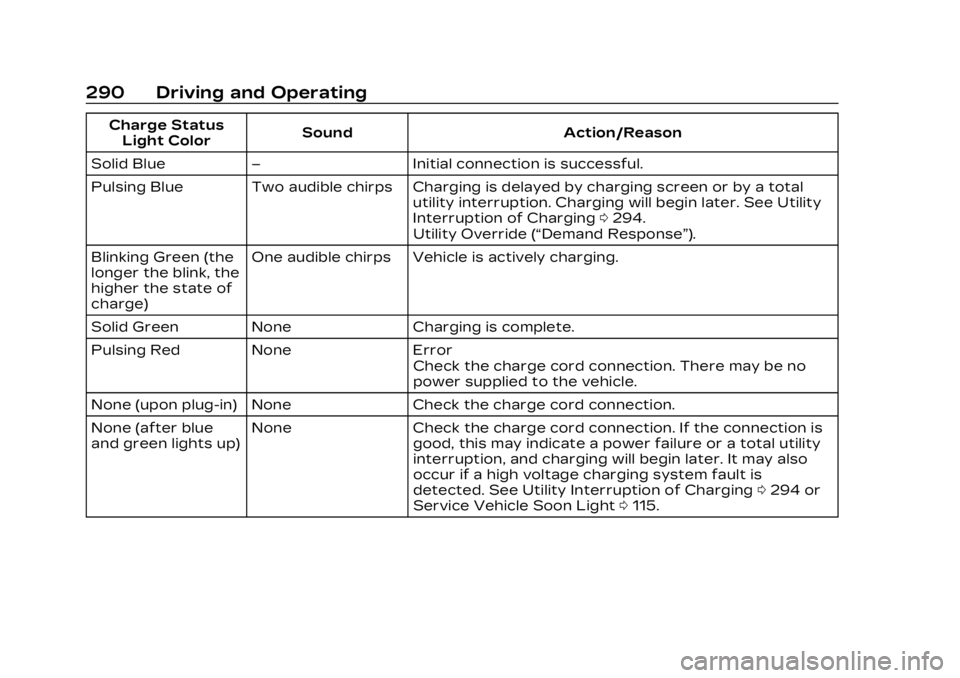
Cadillac Lyriq Owner Manual (GMNA-Localizing-U.S./Canada-15644413) -
2023 - CRC - 2/23/22
290 Driving and Operating
Charge StatusLight Color Sound Action/Reason
Solid Blue – Initial connection is successful.
Pulsing Blue Two audible chirps Charging is delayed by charging screen or by a total utility interruption. Charging will begin later. See Utility
Interruption of Charging0294.
Utility Override (“Demand Response”).
Blinking Green (the
longer the blink, the
higher the state of
charge) One audible chirps Vehicle is actively charging.
Solid Green None Charging is complete.
Pulsing Red None Error Check the charge cord connection. There may be no
power supplied to the vehicle.
None (upon plug-in) None Check the charge cord connection.
None (after blue
and green lights up) None Check the charge cord connection. If the connection is
good, this may indicate a power failure or a total utility
interruption, and charging will begin later. It may also
occur if a high voltage charging system fault is
detected. See Utility Interruption of Charging 0294 or
Service Vehicle Soon Light 0115.
Page 292 of 424
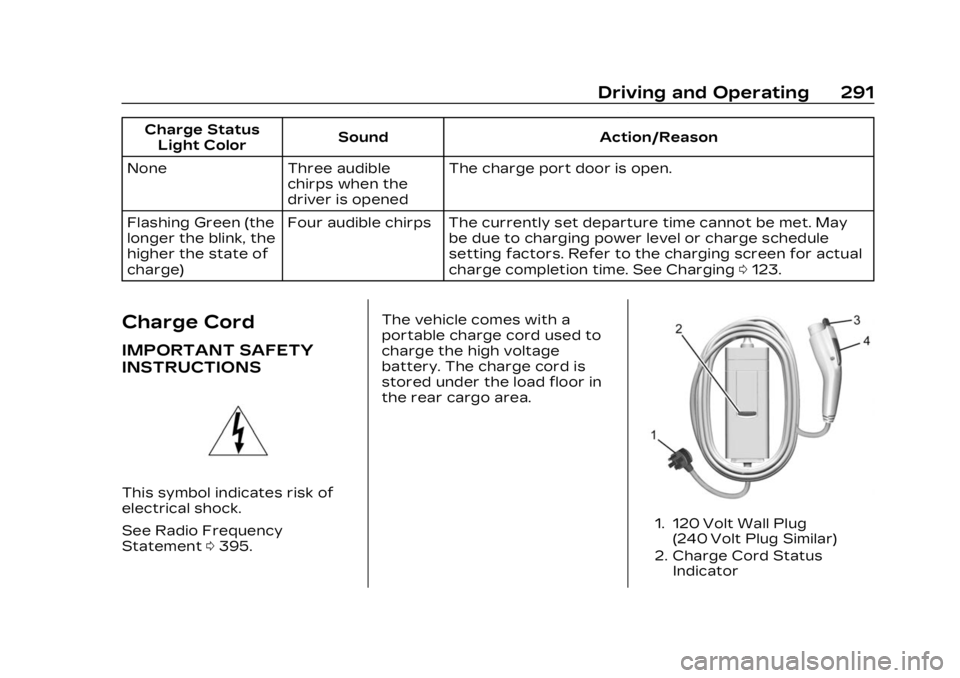
Cadillac Lyriq Owner Manual (GMNA-Localizing-U.S./Canada-15644413) -
2023 - CRC - 2/23/22
Driving and Operating 291
Charge StatusLight Color Sound Action/Reason
None Three audible chirps when the
driver is opened The charge port door is open.
Flashing Green (the
longer the blink, the
higher the state of
charge) Four audible chirps The currently set departure time cannot be met. May
be due to charging power level or charge schedule
setting factors. Refer to the charging screen for actual
charge completion time. See Charging 0123.
Charge Cord
IMPORTANT SAFETY
INSTRUCTIONS
This symbol indicates risk of
electrical shock.
See Radio Frequency
Statement 0395. The vehicle comes with a
portable charge cord used to
charge the high voltage
battery. The charge cord is
stored under the load floor in
the rear cargo area.
1. 120 Volt Wall Plug
(240 Volt Plug Similar)
2. Charge Cord Status Indicator
Page 293 of 424
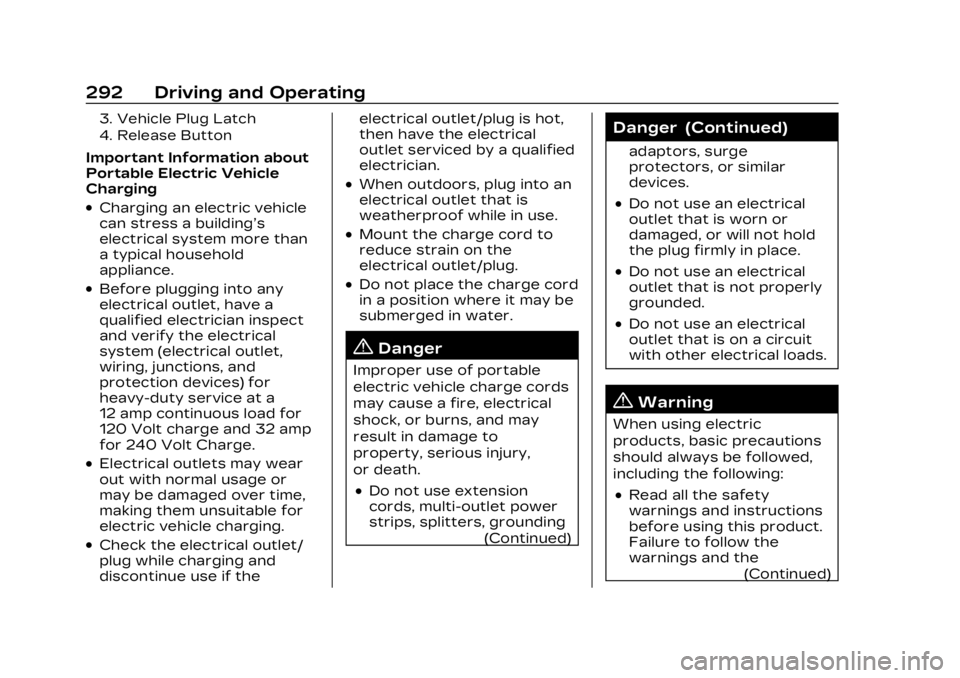
Cadillac Lyriq Owner Manual (GMNA-Localizing-U.S./Canada-15644413) -
2023 - CRC - 2/23/22
292 Driving and Operating
3. Vehicle Plug Latch
4. Release Button
Important Information about
Portable Electric Vehicle
Charging
.Charging an electric vehicle
can stress a building’s
electrical system more than
a typical household
appliance.
.Before plugging into any
electrical outlet, have a
qualified electrician inspect
and verify the electrical
system (electrical outlet,
wiring, junctions, and
protection devices) for
heavy-duty service at a
12 amp continuous load for
120 Volt charge and 32 amp
for 240 Volt Charge.
.Electrical outlets may wear
out with normal usage or
may be damaged over time,
making them unsuitable for
electric vehicle charging.
.Check the electrical outlet/
plug while charging and
discontinue use if theelectrical outlet/plug is hot,
then have the electrical
outlet serviced by a qualified
electrician.
.When outdoors, plug into an
electrical outlet that is
weatherproof while in use.
.Mount the charge cord to
reduce strain on the
electrical outlet/plug.
.Do not place the charge cord
in a position where it may be
submerged in water.
{Danger
Improper use of portable
electric vehicle charge cords
may cause a fire, electrical
shock, or burns, and may
result in damage to
property, serious injury,
or death.
.Do not use extension
cords, multi-outlet power
strips, splitters, grounding
(Continued)
Danger (Continued)
adaptors, surge
protectors, or similar
devices.
.Do not use an electrical
outlet that is worn or
damaged, or will not hold
the plug firmly in place.
.Do not use an electrical
outlet that is not properly
grounded.
.Do not use an electrical
outlet that is on a circuit
with other electrical loads.
{Warning
When using electric
products, basic precautions
should always be followed,
including the following:
.Read all the safety
warnings and instructions
before using this product.
Failure to follow the
warnings and the(Continued)
Page 294 of 424
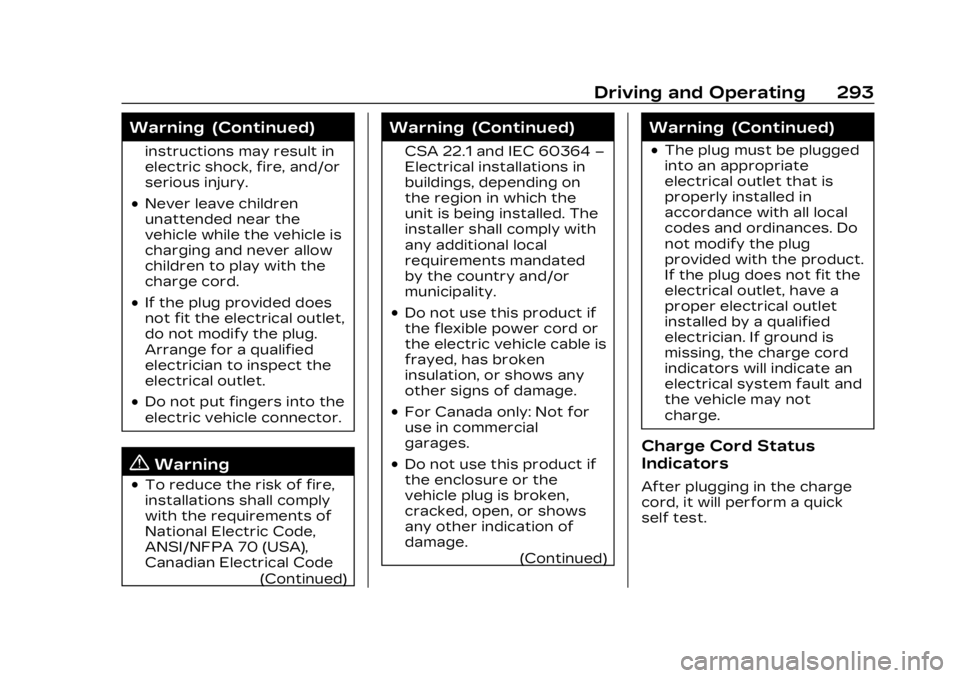
Cadillac Lyriq Owner Manual (GMNA-Localizing-U.S./Canada-15644413) -
2023 - CRC - 2/23/22
Driving and Operating 293
Warning (Continued)
instructions may result in
electric shock, fire, and/or
serious injury.
.Never leave children
unattended near the
vehicle while the vehicle is
charging and never allow
children to play with the
charge cord.
.If the plug provided does
not fit the electrical outlet,
do not modify the plug.
Arrange for a qualified
electrician to inspect the
electrical outlet.
.Do not put fingers into the
electric vehicle connector.
{Warning
.To reduce the risk of fire,
installations shall comply
with the requirements of
National Electric Code,
ANSI/NFPA 70 (USA),
Canadian Electrical Code(Continued)
Warning (Continued)
CSA 22.1 and IEC 60364 –
Electrical installations in
buildings, depending on
the region in which the
unit is being installed. The
installer shall comply with
any additional local
requirements mandated
by the country and/or
municipality.
.Do not use this product if
the flexible power cord or
the electric vehicle cable is
frayed, has broken
insulation, or shows any
other signs of damage.
.For Canada only: Not for
use in commercial
garages.
.Do not use this product if
the enclosure or the
vehicle plug is broken,
cracked, open, or shows
any other indication of
damage.
(Continued)
Warning (Continued)
.The plug must be plugged
into an appropriate
electrical outlet that is
properly installed in
accordance with all local
codes and ordinances. Do
not modify the plug
provided with the product.
If the plug does not fit the
electrical outlet, have a
proper electrical outlet
installed by a qualified
electrician. If ground is
missing, the charge cord
indicators will indicate an
electrical system fault and
the vehicle may not
charge.
Charge Cord Status
Indicators
After plugging in the charge
cord, it will perform a quick
self test.
Page 295 of 424
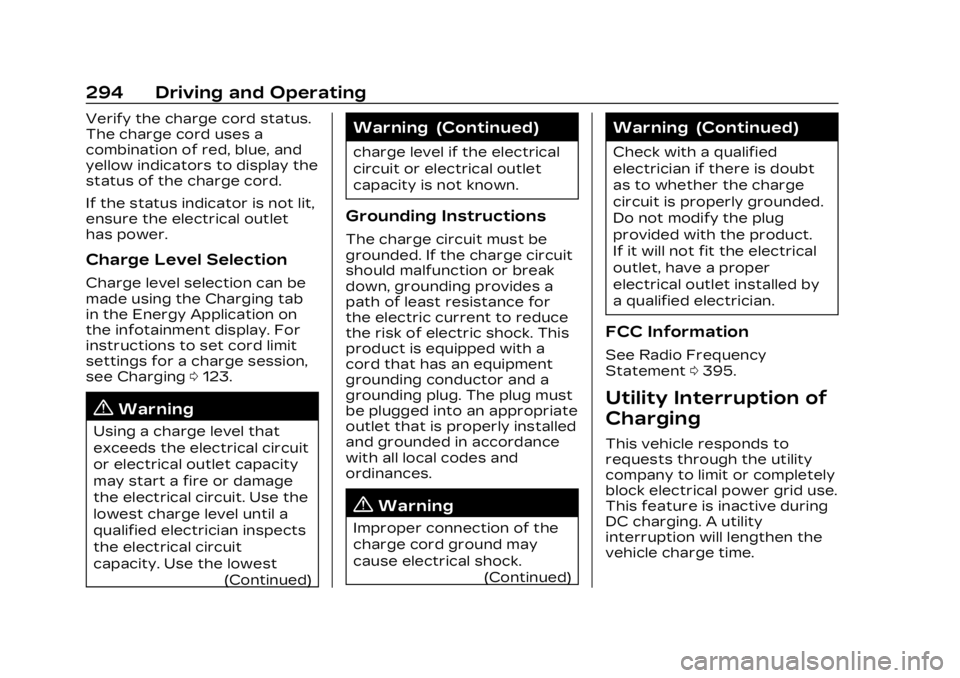
Cadillac Lyriq Owner Manual (GMNA-Localizing-U.S./Canada-15644413) -
2023 - CRC - 2/23/22
294 Driving and Operating
Verify the charge cord status.
The charge cord uses a
combination of red, blue, and
yellow indicators to display the
status of the charge cord.
If the status indicator is not lit,
ensure the electrical outlet
has power.
Charge Level Selection
Charge level selection can be
made using the Charging tab
in the Energy Application on
the infotainment display. For
instructions to set cord limit
settings for a charge session,
see Charging0123.
{Warning
Using a charge level that
exceeds the electrical circuit
or electrical outlet capacity
may start a fire or damage
the electrical circuit. Use the
lowest charge level until a
qualified electrician inspects
the electrical circuit
capacity. Use the lowest
(Continued)
Warning (Continued)
charge level if the electrical
circuit or electrical outlet
capacity is not known.
Grounding Instructions
The charge circuit must be
grounded. If the charge circuit
should malfunction or break
down, grounding provides a
path of least resistance for
the electric current to reduce
the risk of electric shock. This
product is equipped with a
cord that has an equipment
grounding conductor and a
grounding plug. The plug must
be plugged into an appropriate
outlet that is properly installed
and grounded in accordance
with all local codes and
ordinances.
{Warning
Improper connection of the
charge cord ground may
cause electrical shock.(Continued)
Warning (Continued)
Check with a qualified
electrician if there is doubt
as to whether the charge
circuit is properly grounded.
Do not modify the plug
provided with the product.
If it will not fit the electrical
outlet, have a proper
electrical outlet installed by
a qualified electrician.
FCC Information
See Radio Frequency
Statement0395.
Utility Interruption of
Charging
This vehicle responds to
requests through the utility
company to limit or completely
block electrical power grid use.
This feature is inactive during
DC charging. A utility
interruption will lengthen the
vehicle charge time.
Page 296 of 424
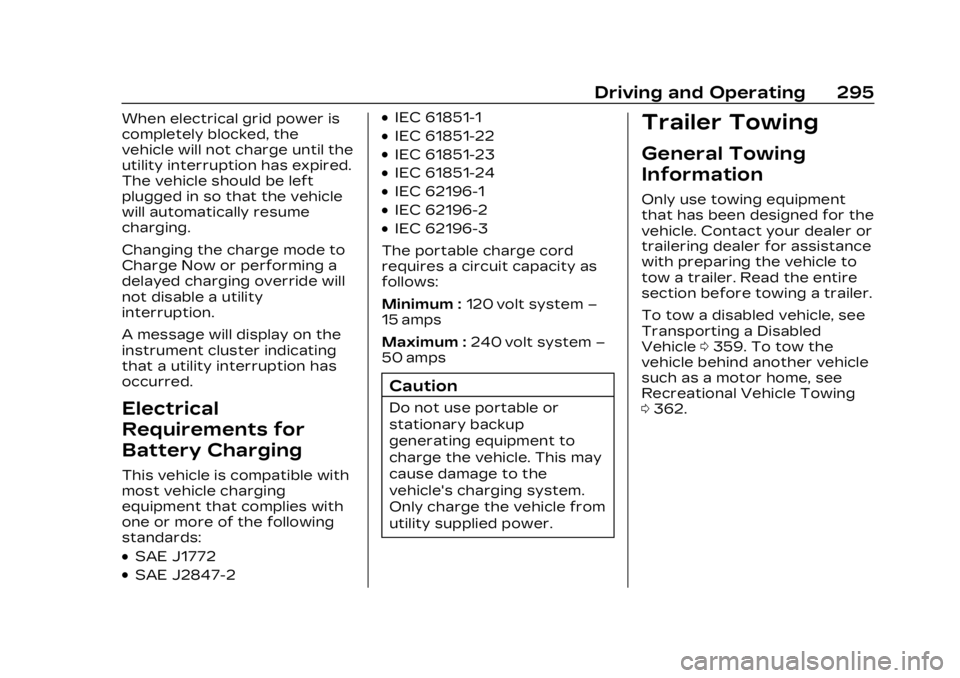
Cadillac Lyriq Owner Manual (GMNA-Localizing-U.S./Canada-15644413) -
2023 - CRC - 2/23/22
Driving and Operating 295
When electrical grid power is
completely blocked, the
vehicle will not charge until the
utility interruption has expired.
The vehicle should be left
plugged in so that the vehicle
will automatically resume
charging.
Changing the charge mode to
Charge Now or performing a
delayed charging override will
not disable a utility
interruption.
A message will display on the
instrument cluster indicating
that a utility interruption has
occurred.
Electrical
Requirements for
Battery Charging
This vehicle is compatible with
most vehicle charging
equipment that complies with
one or more of the following
standards:
.SAE J1772
.SAE J2847-2
.IEC 61851-1
.IEC 61851-22
.IEC 61851-23
.IEC 61851-24
.IEC 62196-1
.IEC 62196-2
.IEC 62196-3
The portable charge cord
requires a circuit capacity as
follows:
Minimum : 120 volt system –
15 amps
Maximum : 240 volt system –
50 amps
Caution
Do not use portable or
stationary backup
generating equipment to
charge the vehicle. This may
cause damage to the
vehicle's charging system.
Only charge the vehicle from
utility supplied power.
Trailer Towing
General Towing
Information
Only use towing equipment
that has been designed for the
vehicle. Contact your dealer or
trailering dealer for assistance
with preparing the vehicle to
tow a trailer. Read the entire
section before towing a trailer.
To tow a disabled vehicle, see
Transporting a Disabled
Vehicle 0359. To tow the
vehicle behind another vehicle
such as a motor home, see
Recreational Vehicle Towing
0 362.
Page 297 of 424
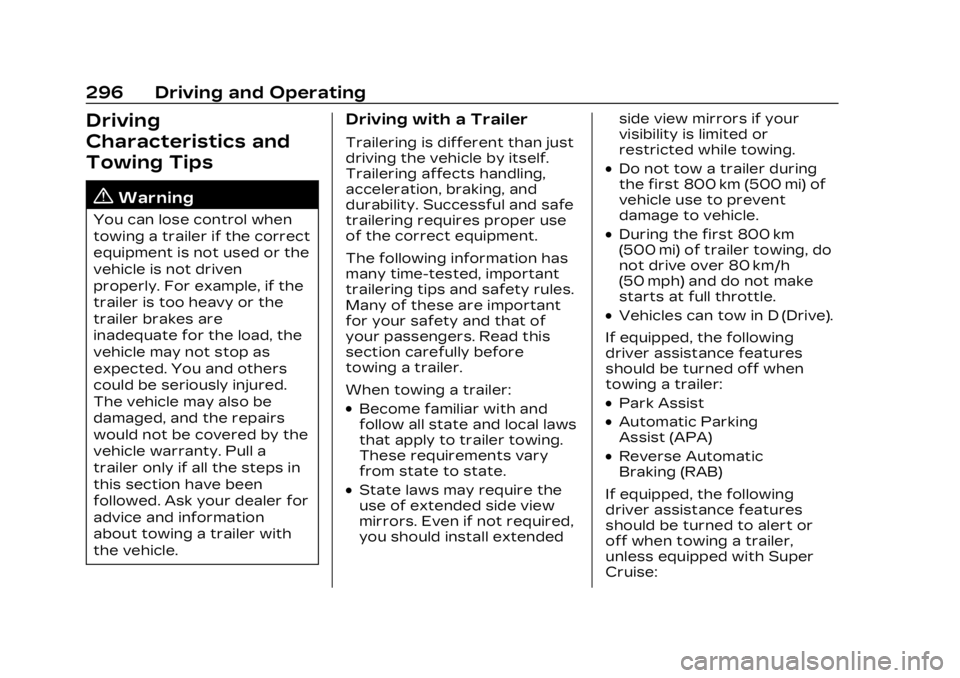
Cadillac Lyriq Owner Manual (GMNA-Localizing-U.S./Canada-15644413) -
2023 - CRC - 2/23/22
296 Driving and Operating
Driving
Characteristics and
Towing Tips
{Warning
You can lose control when
towing a trailer if the correct
equipment is not used or the
vehicle is not driven
properly. For example, if the
trailer is too heavy or the
trailer brakes are
inadequate for the load, the
vehicle may not stop as
expected. You and others
could be seriously injured.
The vehicle may also be
damaged, and the repairs
would not be covered by the
vehicle warranty. Pull a
trailer only if all the steps in
this section have been
followed. Ask your dealer for
advice and information
about towing a trailer with
the vehicle.
Driving with a Trailer
Trailering is different than just
driving the vehicle by itself.
Trailering affects handling,
acceleration, braking, and
durability. Successful and safe
trailering requires proper use
of the correct equipment.
The following information has
many time-tested, important
trailering tips and safety rules.
Many of these are important
for your safety and that of
your passengers. Read this
section carefully before
towing a trailer.
When towing a trailer:
.Become familiar with and
follow all state and local laws
that apply to trailer towing.
These requirements vary
from state to state.
.State laws may require the
use of extended side view
mirrors. Even if not required,
you should install extendedside view mirrors if your
visibility is limited or
restricted while towing.
.Do not tow a trailer during
the first 800 km (500 mi) of
vehicle use to prevent
damage to vehicle.
.During the first 800 km
(500 mi) of trailer towing, do
not drive over 80 km/h
(50 mph) and do not make
starts at full throttle.
.Vehicles can tow in D (Drive).
If equipped, the following
driver assistance features
should be turned off when
towing a trailer:
.Park Assist
.Automatic Parking
Assist (APA)
.Reverse Automatic
Braking (RAB)
If equipped, the following
driver assistance features
should be turned to alert or
off when towing a trailer,
unless equipped with Super
Cruise:
Page 298 of 424
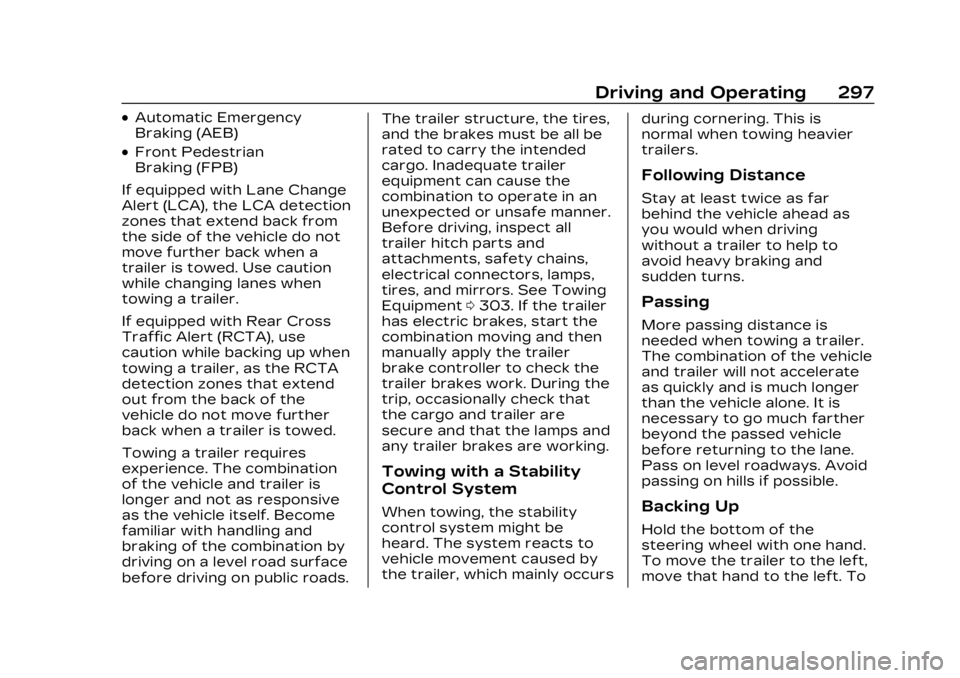
Cadillac Lyriq Owner Manual (GMNA-Localizing-U.S./Canada-15644413) -
2023 - CRC - 2/23/22
Driving and Operating 297
.Automatic Emergency
Braking (AEB)
.Front Pedestrian
Braking (FPB)
If equipped with Lane Change
Alert (LCA), the LCA detection
zones that extend back from
the side of the vehicle do not
move further back when a
trailer is towed. Use caution
while changing lanes when
towing a trailer.
If equipped with Rear Cross
Traffic Alert (RCTA), use
caution while backing up when
towing a trailer, as the RCTA
detection zones that extend
out from the back of the
vehicle do not move further
back when a trailer is towed.
Towing a trailer requires
experience. The combination
of the vehicle and trailer is
longer and not as responsive
as the vehicle itself. Become
familiar with handling and
braking of the combination by
driving on a level road surface
before driving on public roads. The trailer structure, the tires,
and the brakes must be all be
rated to carry the intended
cargo. Inadequate trailer
equipment can cause the
combination to operate in an
unexpected or unsafe manner.
Before driving, inspect all
trailer hitch parts and
attachments, safety chains,
electrical connectors, lamps,
tires, and mirrors. See Towing
Equipment
0303. If the trailer
has electric brakes, start the
combination moving and then
manually apply the trailer
brake controller to check the
trailer brakes work. During the
trip, occasionally check that
the cargo and trailer are
secure and that the lamps and
any trailer brakes are working.
Towing with a Stability
Control System
When towing, the stability
control system might be
heard. The system reacts to
vehicle movement caused by
the trailer, which mainly occurs during cornering. This is
normal when towing heavier
trailers.
Following Distance
Stay at least twice as far
behind the vehicle ahead as
you would when driving
without a trailer to help to
avoid heavy braking and
sudden turns.
Passing
More passing distance is
needed when towing a trailer.
The combination of the vehicle
and trailer will not accelerate
as quickly and is much longer
than the vehicle alone. It is
necessary to go much farther
beyond the passed vehicle
before returning to the lane.
Pass on level roadways. Avoid
passing on hills if possible.
Backing Up
Hold the bottom of the
steering wheel with one hand.
To move the trailer to the left,
move that hand to the left. To
Page 299 of 424
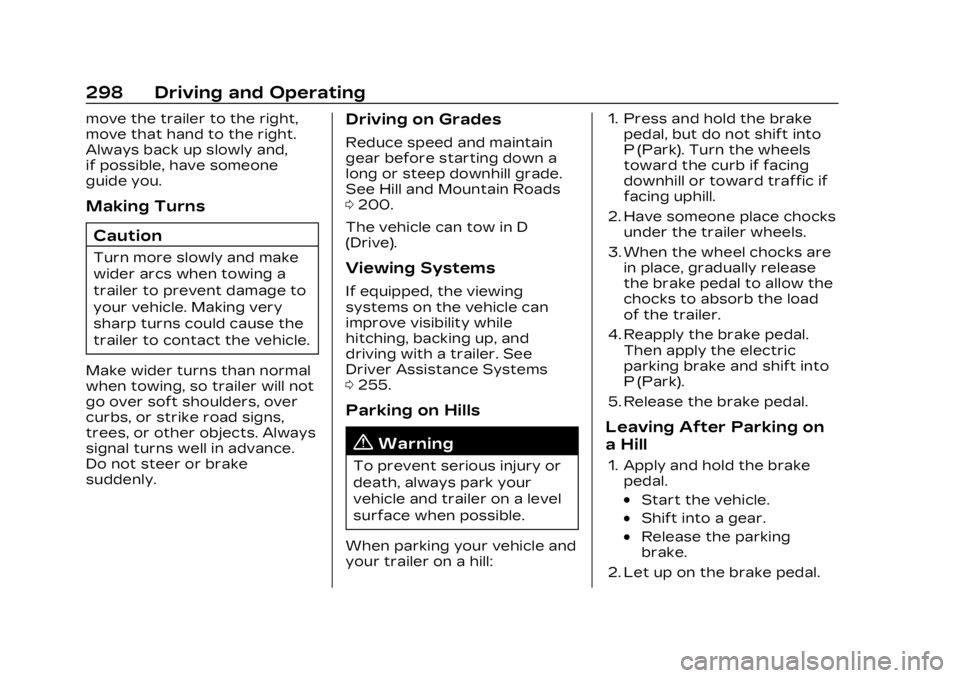
Cadillac Lyriq Owner Manual (GMNA-Localizing-U.S./Canada-15644413) -
2023 - CRC - 2/23/22
298 Driving and Operating
move the trailer to the right,
move that hand to the right.
Always back up slowly and,
if possible, have someone
guide you.
Making TurnsCaution
Turn more slowly and make
wider arcs when towing a
trailer to prevent damage to
your vehicle. Making very
sharp turns could cause the
trailer to contact the vehicle.
Make wider turns than normal
when towing, so trailer will not
go over soft shoulders, over
curbs, or strike road signs,
trees, or other objects. Always
signal turns well in advance.
Do not steer or brake
suddenly.
Driving on Grades
Reduce speed and maintain
gear before starting down a
long or steep downhill grade.
See Hill and Mountain Roads
0 200.
The vehicle can tow in D
(Drive).
Viewing Systems
If equipped, the viewing
systems on the vehicle can
improve visibility while
hitching, backing up, and
driving with a trailer. See
Driver Assistance Systems
0 255.
Parking on Hills
{Warning
To prevent serious injury or
death, always park your
vehicle and trailer on a level
surface when possible.
When parking your vehicle and
your trailer on a hill: 1. Press and hold the brake
pedal, but do not shift into
P (Park). Turn the wheels
toward the curb if facing
downhill or toward traffic if
facing uphill.
2. Have someone place chocks under the trailer wheels.
3. When the wheel chocks are in place, gradually release
the brake pedal to allow the
chocks to absorb the load
of the trailer.
4. Reapply the brake pedal. Then apply the electric
parking brake and shift into
P (Park).
5. Release the brake pedal.
Leaving After Parking on
a Hill
1. Apply and hold the brake pedal.
.Start the vehicle.
.Shift into a gear.
.Release the parking
brake.
2. Let up on the brake pedal.
Page 300 of 424
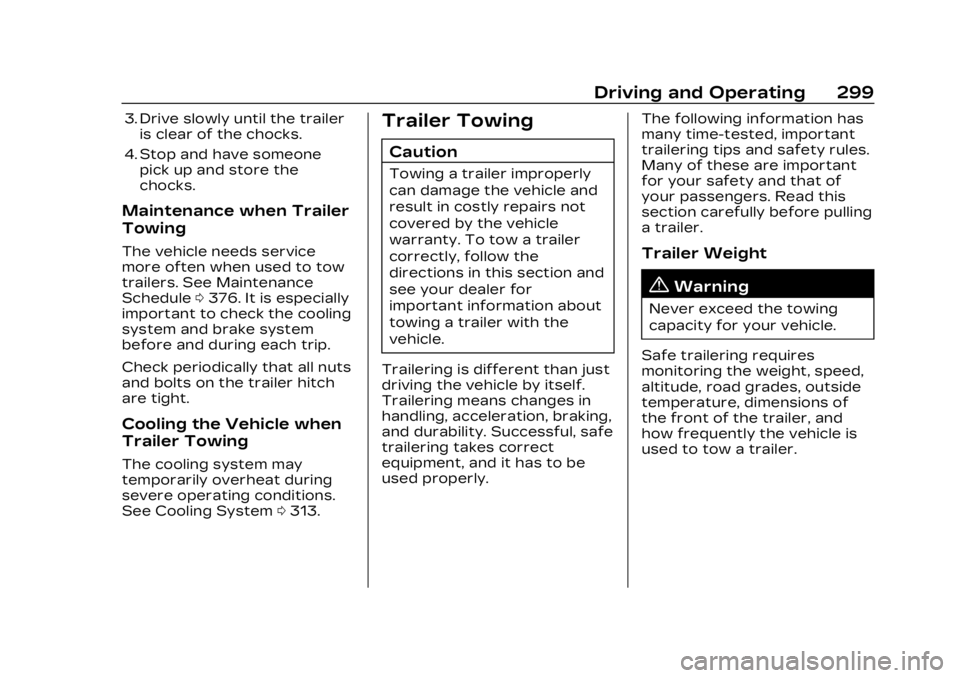
Cadillac Lyriq Owner Manual (GMNA-Localizing-U.S./Canada-15644413) -
2023 - CRC - 2/23/22
Driving and Operating 299
3. Drive slowly until the traileris clear of the chocks.
4. Stop and have someone pick up and store the
chocks.
Maintenance when Trailer
Towing
The vehicle needs service
more often when used to tow
trailers. See Maintenance
Schedule 0376. It is especially
important to check the cooling
system and brake system
before and during each trip.
Check periodically that all nuts
and bolts on the trailer hitch
are tight.
Cooling the Vehicle when
Trailer Towing
The cooling system may
temporarily overheat during
severe operating conditions.
See Cooling System 0313.
Trailer Towing
Caution
Towing a trailer improperly
can damage the vehicle and
result in costly repairs not
covered by the vehicle
warranty. To tow a trailer
correctly, follow the
directions in this section and
see your dealer for
important information about
towing a trailer with the
vehicle.
Trailering is different than just
driving the vehicle by itself.
Trailering means changes in
handling, acceleration, braking,
and durability. Successful, safe
trailering takes correct
equipment, and it has to be
used properly. The following information has
many time-tested, important
trailering tips and safety rules.
Many of these are important
for your safety and that of
your passengers. Read this
section carefully before pulling
a trailer.
Trailer Weight
{Warning
Never exceed the towing
capacity for your vehicle.
Safe trailering requires
monitoring the weight, speed,
altitude, road grades, outside
temperature, dimensions of
the front of the trailer, and
how frequently the vehicle is
used to tow a trailer.